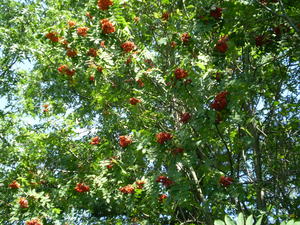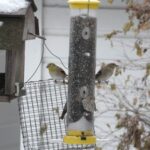Many trees in large swaths of North America are brilliant orange-red during August and into September. It has nothing to do with the leaves, which are waiting their turn to display, but the ripening of brilliant red berries on the native American Mountain Ash.
While a brilliant color display can be second to rival autumn leave color, the berries are a favorite wildlife food for many birds and mammals during the fall and winter months. Grouse, the jays and robins in particular relish the berries as do squirrels and rabbits.
The American Mountain Ash, technically known as Sorbus americana, is actually not a member of the Ash tree family. Sorbus is a genus related to crab apples and cherry trees along with 1,500 other members.
Ash trees (technically Fraxinus) are being decimated by an invasive critter, called the Emerald Ash Borer (EAB) in many sections of North America. Some even fear the Ash tree could go the way of the once King of the Forest, the American Chestnut. The EAB is not a problem on American Mountain Ash trees, although another invasive, the Gypsy Moth can be a serious threat.
The American Mountain Ash tree can found at higher elevations,and enjoys fertile, moist ground with a pH level between 4.7 and 6.0. It can often be found growing in open meadows and near or just inside the tree line of a woodland. It enjoys full sun but can be grown easily in shade.
The tree was well known to the First Peoples in the northern regions of the Hemisphere. In some traditions, there is a story about one particular harsh winter when everything was dying because of the lack of food. After praying, the people were instructed to take the blood from the dead animals and smear it on the trees. The next morning, the trees had an abundance of red berries for the people and animals to eat saving them from ultimate starvation.
Some of the folklore surrounding the tree is about weather. In some regions an abundance of berries predicts a mild winter ahead. With a developing El Nino this summer, 2008 – 2010, there are indications of mild winter for many northern regions. Maybe the Mountain Ash trees knew this all along, since there seems to be a heavy crop of berries this year as can be seen in the photographs.
The berries are edible. Mountain Ash berries can be eaten fresh, dried for later use, or used to make a jelly. The berries have a somewhat bitter taste and the jelly was used as a condiment for strong flavored wild game meat. There are also some indications the berries could be used for make wine and a tea.
The Mountain Ash berries were also reputed to have medicinal qualities and were known to help a person’s vocal chords. It was also used for inflamed tonsils and sore throats.
Today, the the winter hardy Mountain Ash tree is used primarily as an ornamental in many yards and in cities because of it’s resistance to smog related pollution. It is a rather small tree, almost a large shrub, but can grow to around thirty feet at best with graceful leaves and a striking smooth bark. Many times, the berries will remain on the tree well into the winter months providing contrast to the otherwise white landscape. In the early spring, the Mountain Ash blooms with large clusters of white flowers.
In many regions, the American Mountain Ash tree is also planted by many civic, conservation groups and state agencies because of it’s environmental benefits for wildlife. The American Mountain Ash is one of the Hemisphere’s most beautiful trees and one of the hardiest. It remains a top choice for landscaping because of it’s simple, rugged and brilliant displays in all seasons. The Mountain Ash displays of August and September are the opening act of even more brilliant and natural displays as summer wanes and autumn begins.





